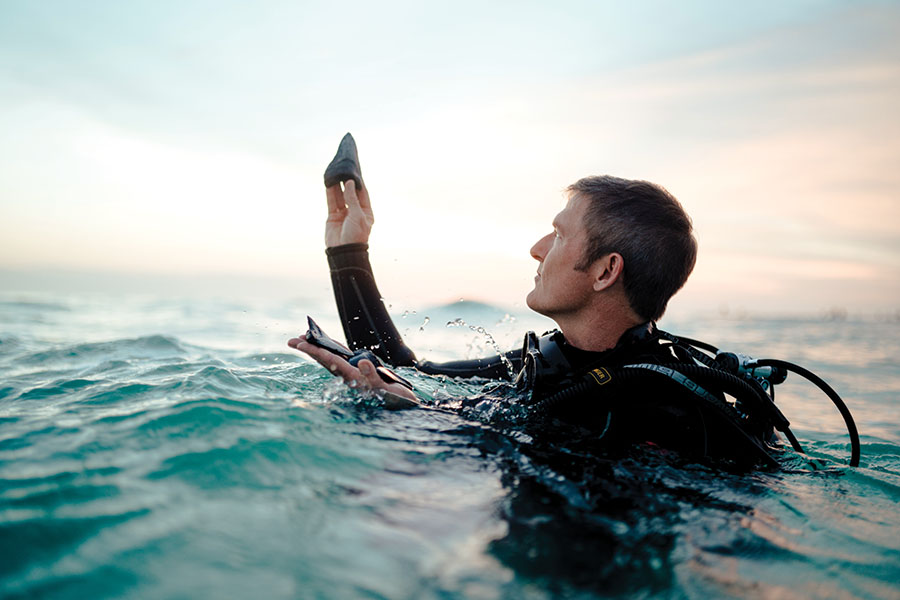In the dark hours of the morning, after a cup of coffee and a hot shower, Zach Frignoca squirms and stretches into a wetsuit still cold and damp from the day before. Soon he will drive a boat off the Venice shore and dive down into the depths—not dredging or digging, but scanning and surveying the ocean floor for prehistoric prizes peeking up and out into the modern world. Frignoca is a shark tooth hunter. He is an adventurer in a most perilous scavenger hunt—a high-risk, high-reward game of hide-and-seek. “If you’re somebody who has a deep understanding of natural history,” he says, “and you’re interested in where you come from, where the earth has been and where it’s going, these teeth tell a big story.”
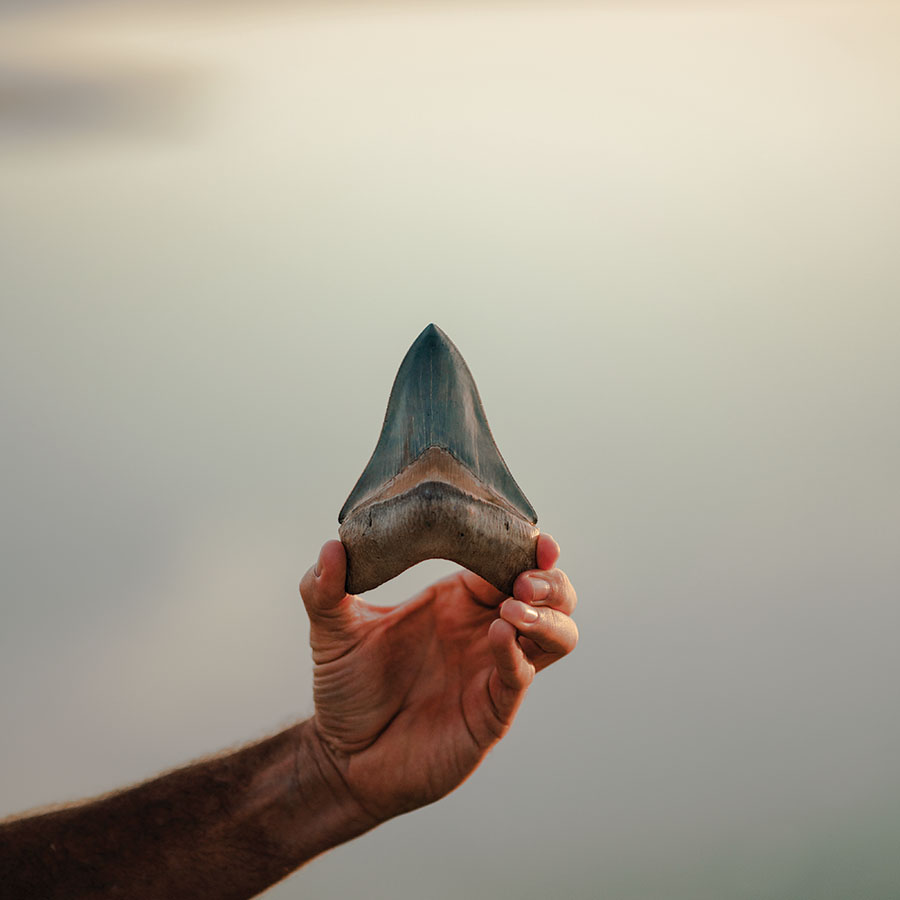
FOSSILIZED SHARK TOOTH COLORATION DEPENDS ON THE SEDIMENT IT HAS BEEN RESTING IN FOR THOUSANDS OR MILLIONS OF YEARS, MAKING EACH FOSSIL DISTINCT.
A diver for more than 30 years, Frignoca began his fossil-hunting expeditions even earlier at age six, when he strapped on a snorkel and joined his dad and the boys at the Peace River. He unearthed Ice Age fossils from megalodons, sharks, mastodons and extinct species of horse. While learning about the shy nature of venomous snakes and how to swim feet from alligators without getting eaten, Frignoca watched his dad catch water snakes with his bare hands and toss snapping turtles at friends. “To me, he was Indiana Jones,” Frignoca says, thinking back to the nights his dad would come home with stories of run-ins with sharks and alligators before giving him a box of found fossils to bring to school the next day—a tradition Frignoca has continued with his own two children. “I wanted to do the same thing,” he says. “I wanted to have those adventures and I wanted it to be part of my job description.”
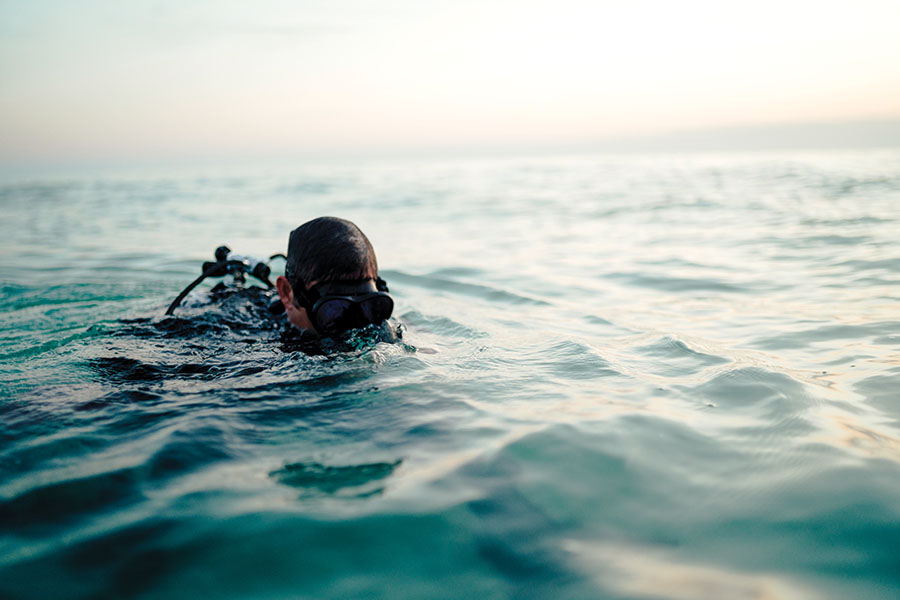
PHOTOGRAPHY BY WYATT KOSTYGAN
For more than 20 years, Frignoca has merged his personal passion with his profession—first supplying other dealers with his own fossil finds as a wholesaler, and now as the owner of Primitive Past, an online dealer of museum-quality fossils from around the world. Recent gems include a Peruvian Chubutensis shark tooth, a Chilean Great White tooth, a Belemnite fossil from Australia, megalodon teeth from Indonesia and red fossil horse teeth from North Florida. In many ways, the fossilized shark teeth market resembles that of any other collector’s items: coins, baseball cards or antique PEZ dispensers. But there’s a reason why people spend hundreds of hours hunting, hundreds of dollars buying, and thousands of hours traveling the world to experience this commodity firsthand. On a primal level, as Frignoca calls it, the aesthetic of any one shark tooth has a strong enough appeal—something to capture everyone’s sense of wonder. Each tooth is distinct in color, texture and shape, in accordance with its fossilization process. But more than that, each tooth encapsulates millions of years of natural history that can sit in the palm of one’s hand. As a businessman, Frignoca sits at his desk, answers emails and scours the internet for more great finds, but he is really an adventurer at heart. He craves a different kind of blue light—a softer shade with streams of sun located a few miles off the coast, where the waters churn and history emerges.
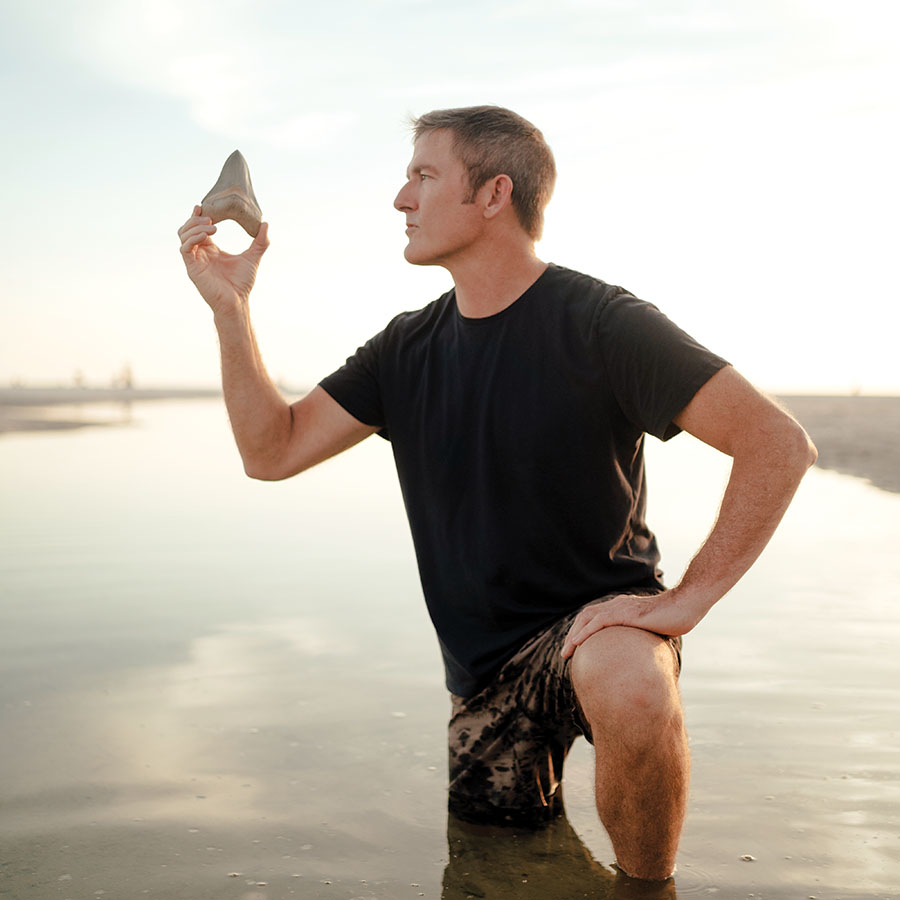
ZACH FRIGNOCA, PROFESSIONAL SHARK TOOTH HUNTER AND OWNER OF PRIMITIVE PAST, DIVES FOR FOSSILIZED SHARK TEETH ALONG THE COAST OF VENICE.
For 24 million years, Florida has wavered in a constant state of existing above and below the water’s surface, where the cold-blooded fish--whose existence has outlived dinosaurs—swam and hunted. There are more than 500 species of shark, and each one can lose 30,000 or more teeth in a lifetime due to having multiple rows of replenishable teeth. In the proper conditions, the enamel allows the teeth to fossilize—a process that requires a minimum of 10,000 years to complete. And Venice, known as “The Shark Tooth Capital of the World,” is prime real estate for hunting and harvesting these millions of fossilized teeth. Venice’s fossil layers lay just beneath the surface due to millions of years of warm, shallow bays that were perfect for breeding. The layers are then constantly exposed and turned over by wind and waves, slowly eroding fossils from the Gulf Coast. Smaller tiger, bull or lemon shark teeth interweave with the sand on Caspersen Beach. But, as you venture further out into the surf, the prizes only grow. “You’re the first person to hold these things that were lost millions of years ago,” Frignoca says. “And when you really think about that, it’s incredible.”
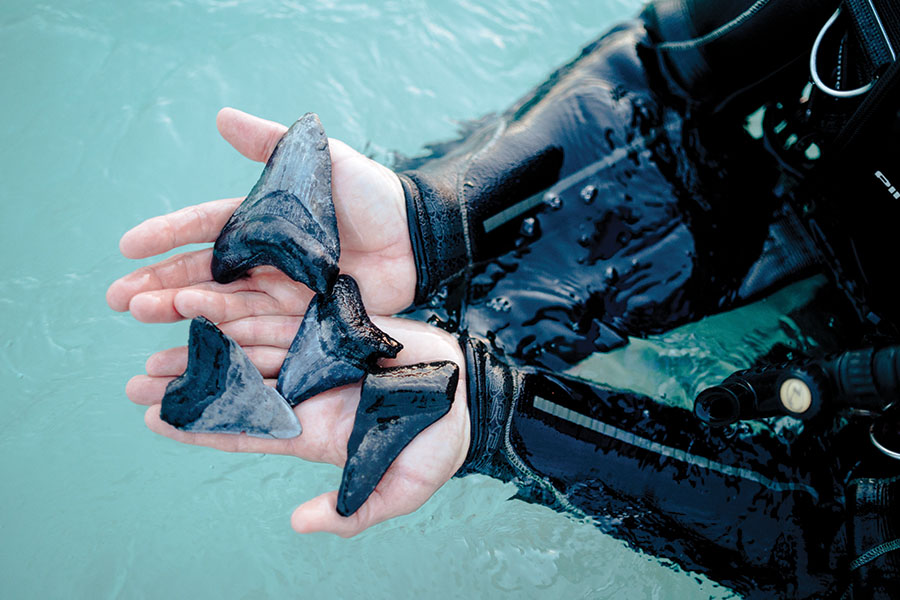
PHOTOGRAPHY BY WYATT KOSTYGAN
Sinking below the surface, shark tooth diving is first and foremost a process of trial and error. “The Gulf of Mexico on the bottom is a lot like a washing machine with each storm,” Frignoca explains. The ocean floor shuffles and shakes after a cold front or hurricane, eroding new fossils and pushing them up into view in the sand below, leaving it littered with fossils. But finding a fruitful site means traveling one quarter to two miles off shore, then continuously diving down and returning to air until discovering a fossil-rich area. If whale bones or dugong rib cages appear (the past meals of megalodons), then the modern hunt begins. Descending with an extra-large oxygen tank and four empty pouches strapped to his chest—some filled with bubble-wrap sleeves for the more precious prizes—Frignoca assesses the surrounding currents, winds and sea life. His surroundings often include clouds of stinging jellyfish, manatee, guitarfish, loggerhead sea turtles and sharks politely coming and going, sharing their space with a fellow hunter. While some divers diligently swim back and forth like a lawnmower across a fossil-rich patch, Frignoca zigzags from above, entering a kind of meditative state while covering as much ground as possible. A predator in his own way, half relaxed and half on high alert, Frignoca is on the hunt. His prize? megalodon teeth—bigger and better than before.
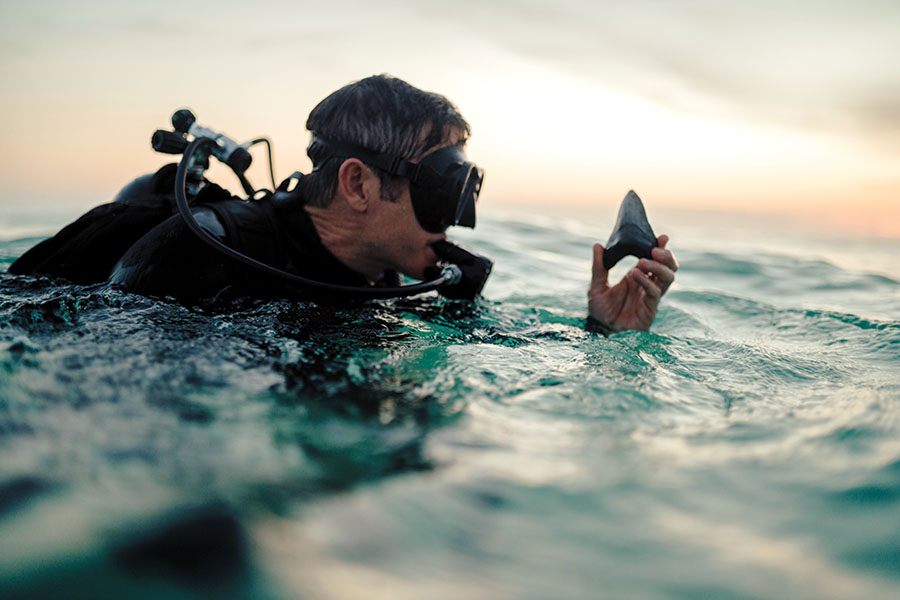
PHOTOGRAPHY BY WYATT KOSTYGAN
“Every time you go diving, you’re hoping to find your next biggest tooth,” he says. For this highly experienced diver, the prize is quality, not quantity because a daily haul will include a megalodon tooth for Frignoca, every time, usually ranging from two to four inches. A recent find that still has him beaming with pride and wonder came a few months ago. Having already dived one tank, Frignoca sat on the boat with a dive partner, honing an inkling that something great was concealed just 30 feet below. Into the ice-cold water and floating high off the ocean floor, he spotted a whale rib on a reef and, below it, a lump in the sand. Reaching down and scooping with his fingers, he lifted a six-and-a-half-inch marbled black-and-brown tooth from the upper jaw of a massive megalodon—every square inch of it distinct from the next. “When you have a tooth of that size in your hand, it looks all of 10 million years old,” he says.
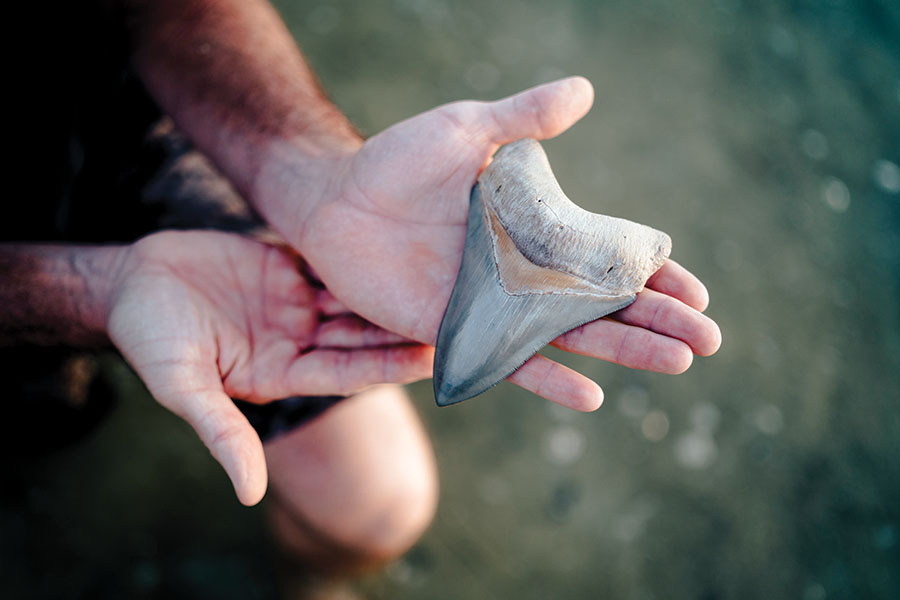
FRIGNOCA CRADLES A FIVE-INCH MEGALODON TOOTH, DISCOVERED RIGHT OFF VENICE BEACH.
Megalodon teeth express the most diversity of color, ranging from marbled blacks, greys, blues and greens—all depending on the sediment they have resided in for tens of thousands of years. These teeth can be found anywhere the earth has been disturbed, sending Frignoca to land sites, creeks, and coastal and inland rivers. “They’re located in the last true pieces of Florida,” he says. “And you’re getting a taste of what Florida was like thousands, if not millions, of years ago.” In true wild Florida style, those areas are populated with rattlesnakes, bull sharks and snapping turtles—even big bull alligators in coffee-colored waters, looking aggressive, unwilling to share their swimming holes.
Frignoca is an adventurer and an explorer, searching for fossils that allow worlds to collide. A solitary diver, he swims along a limestone reef on the Venice coast, pouches full with the teeth of jaws past. Then, in a moment of historic serendipity, the shape of a large creature emerges from the dark—intimidating but docile and calm. A nurse shark. It stops, pausing just beneath the diver’s legs. “The only thing I could think to do,” says Frignoca, “was gently pet its head. And I did. Then he just swam off.” And so it goes for the life of a shark tooth hunter. SRQ
Primitive Past, primitivepast.com





